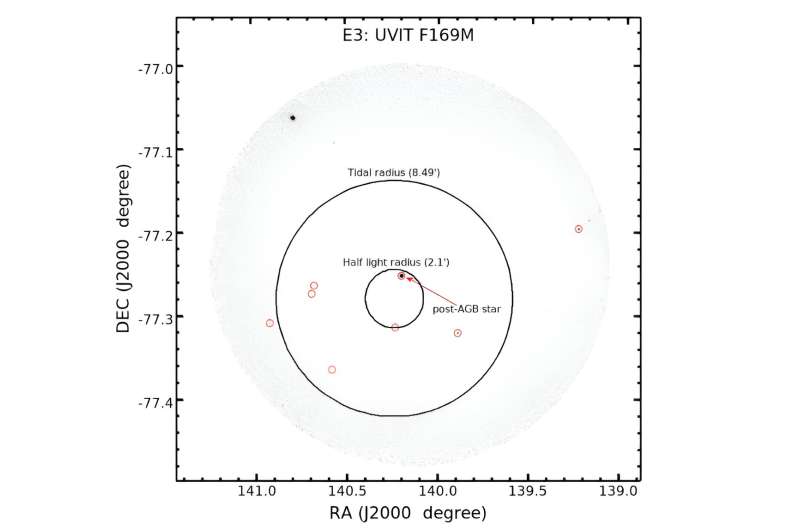March 25, 2024 report
This article has been reviewed according to Science X's editorial process and policies. Editors have highlighted the following attributes while ensuring the content's credibility:
fact-checked
preprint
trusted source
proofread
Hot post-asymptotic giant branch star discovered in globular cluster ESO 37-1

Astronomers have discovered a new post-asymptotic giant branch (PAGB) star in a Galactic globular cluster known as ESO 37-1 (or E3 for short) and derived its fundamental parameters. The finding is reported in a research paper published March 19 on the preprint server arXiv.
PAGB stars are luminous supergiant stars of intermediate mass in a very late phase of stellar evolution. Although they are rarely found in globular clusters (GCs), due to their very short lifetime of less than 500,000 years, they are the most luminous objects in these clusters.
Recently, a team of astronomers led by Ranjan Kumar of the Physical Research Laboratory (PRL) in Ahmedabad, India, has found a new rare PAGB in a globular cluster. They used AstroSat and Gaia satellites to investigate E3—one of the faintest and least massive (with a mass of only 2,900 solar masses) GCs in the Milky Way galaxy, located some 32,600 light years away. The star was identified by analyzing the data from AstroSat's Ultraviolet Imaging Telescope (UVIT) and from Gaia's Early Data Release 3 (EDR3).
"We explore all the photometric and spectroscopic details of the new hot-PAGB star discovered in GC E3. The proper motion and parallax of the star from Gaia EDR3 support its membership, and the location of the star in the absolute CMD [color-magnitude diagram] suggests that the star is in the PAGB phase," the researchers wrote in the paper.
The newfound PAGB star in E3 is about 4.61 times larger than the sun, has a mass of about 0.51–0.55 solar masses, and its effective temperature is 17,500 K. The star has a metallicity of approximately -0.7 dex, which is in agreement with the cluster's metallicity, and turned out to be carbon and oxygen enriched.
The radial velocities of the newly detected star show a variation of about 6 km/s between the two epochs of observation. This indicates a binary nature of the star, and simulations conducted by Kumar's team suggest a binary period of 39.12 or 17.83 days. The companion object is likely an evolved post-main sequence star with an estimated mass of 0.5–0.8 solar masses.
The astronomers noted that the new PAGB star has carbon and oxygen abundances generally similar to those PAGB stars of other GCs that have undergone the so-called third dredge-up (3DU). Therefore, this suggests that the PAGB star in E3 also went to the 3DU while on its asymptotic giant branch evolution and enriched its carbon and oxygen abundances.
In concluding remarks, the authors of the paper underlined the need for future multi-epoch spectroscopic observations that are necessary to constrain the period and better understand the binary nature of the newly detected PAGB star in the E3 cluster.
More information: R. Kumar et al, Discovery of a hot post-AGB star in Galactic globular cluster E3, arXiv (2024). DOI: 10.48550/arxiv.2403.12907
Journal information: arXiv
© 2024 Science X Network





















